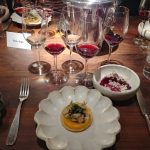Beaujolais is a misunderstood wine region. I say that because, on one hand, the Beaujolais Nouveau that is released every November in celebration of the year’s first wine offering and the festival that goes along with it, has put the region on the international map. However it has also limited global knowledge of Beaujolais’s wine offerings to that of Beaujolais Nouveau. Beaujolais Nouveau, as the name suggests, is a very young wine. It is bottled shortly after the grapes are harvested with very little time spent on the lees. It is young, fresh and light in character. Some of the Beaujolais Nouveau sold in The United States and elsewhere outside of Europe has garnered a reputation for being of poor quality and flavor. It also tends to give you a vicious hangover. This is partly due to the fact that much of the Beaujolais Nouveau that is sold abroad is produced in huge quantities and processed in sealed tanks that are injected with carbon to accelerate fermentation and get the wine to market quickly. The result is a premature, overly processed wine that gives off an odor some wine drinkers describe as being reminiscent of bubble gum or gum drops, while others say they smell gasoline. Even those who find these wines drinkable feel that the wine is thin, and lacks structure, complexity and balance. But one bad apple — or in this case — grape does not characterize the whole bunch. The colorfully labeled Beaujolais Nouveau that arrives on wine store shelves around Thanksgiving every year under a “Celebrate Beaujolais Nouveau” banner for usually under $10.00 is not all this Southern French A.O.C. designated wine making region has to offer.
A few technical facts about Beaujolais.
The red grape Gamay is the dominant varietal grown in Beaujolais. Red wine constitutes 98% of wine production in Beaujolais. The white grape Chardonnay is also cultivated in small but increasing quantities. Beaujolais is flanked by Maconnais, a part of the preeminent wine territory of Burgundy. The Saone River lies to the East, the Monts du Beaujolais to the West. Head south of Beaujolais and you will find Lyon, about 2 hours outside Paris.
The climate in Beaujolais is prime for wine making. The winters are cold, the summers are warm and dry, and sunshine persists through Fall. The Nizerand River runs through it. The soil in the Northern part is characterized by granite, and in the South, it is limestone. Beaujolais boasts 2000 years of wine making history and like most of Western Europe they have the Romans to thank for it.
Beaujolais is comprised of 3 appellations. Beaujolais and Beaujolais Nouveau consist of 72 villages. Beaujolais Villages and Beaujolais Village Nouveau, 38 villages. The final and most prestigious appellation, the Beaujolais Crus are made up of 10 villages characterized by Southeast facing hillside vineyards that ensure ample sunlight.
Gamay is a remarkably versatile grape that exhibits a wide range of flavor profiles. Beaujolais wines from Beaujolais, Beaujolais Nouveau, Beaujolais Villages, and Beaujolais Villages Nouveau tend to exhibit a fresh and vivacious fruit character. Wines from Chenas, Cote de Brouilly, Julienas, Morgon and Moulin a Vent have a bright and refreshing fruit character that deepens and grows in complexity when aged.
The beauty of Gamay is that it bridges the gap between those who enjoy white wine because of its fresh, fruit driven properties and those who also favor lighter wines but prefer red varietals. Beaujolais from Moulin a Vent are best enjoyed chilled, making it a great red wine candidate come Spring, Summer and Fall. Beaujolais can also join the red wine line up come Winter when a chilled white or rose’ might not be top of mind because then wine drinkers are looking for something with greater richness and weight because Beaujolais Crus from Brouilly, Chiroubles, Fleurie, Regnie, and Saint Amour run the gamut of flavor profiles, from floral and fruit driven, to earthy and concentrated with well balanced tannins.



Roughly a dozen of us in the food and wine writing industry were given the opportunity to experience the versatility of Gamay as both expressions of different appellations and as food pairing candidates. 4 courses were paired with 8 wines at La Mercerie, a delightful French Mediterranean Restaurant, Cafe and boutique off Canal Street in Soho, New York City.

A trio of Beaujolais including a floral, crisp and ripe citrus and orchard fruit driven Jean Paul Brun Chardonnay, Beaujolais Blanc, 2017, a soft and delicate strawberry and raspberry dominant La Rosee’ de Julie, Franck Besson Beaujolais Rose’, 2018 and a well rounded Bonnet Rouge Gamay, 2013 with a fresh and juicy sweet cherry and blackberry character, along with soft tannins were paired with saffron aioli filled olives, a foie millefeuille, and mini sacristains.

Two reds, a Charly Thevenet, Reignie’ “Grain and Granit,” 2016 characterized by notes of juicy dark berries and orange rind, along with bright acidity and a lingering finish and a Domaine Piron Lameloise Quartz Chenas, 2014 with fresh raspberry and cherry aromas, hints of herbs and earth, and cranberry, plum and dark berry notes along with a measure of acidity complemented a beautifully presented second course of wild mushroom tart.

Three more reds followed.
A Domaine Cheysson, Chiroubles, 2017 with vivacious notes of sweet raspberries, blackberries and plums, as well as an elegant finish was poured with a beet and smoked eel. A Chateau des Jacques, Moulin a Vent, 2016 with fresh acidity and juicy notes of red and dark fruit, a touch of spice, and a slightly mineral driven finish and a Domaine du Pavillon de Chavannes Cuvee des Ambasades, Cote de Brouilly, 2016 with pronounced acidity, sour cherry and plum notes, and a touch of mineral and wood was paired with a poached chicken breast in a light butter based sauce with potato puree.

Finally, a rich and airy hazelnut buttercream filled chou puff pastry topped with toasted hazelnuts was presented to top off an already artfully presented and decadent meal.


Be First to Comment